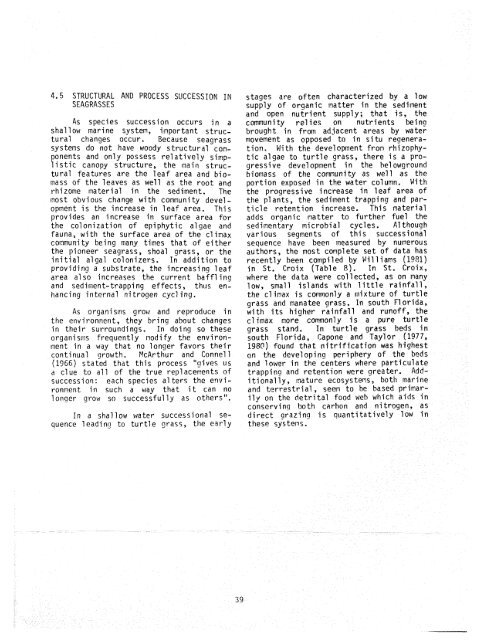The Ecology of the Seagrasses of South Florida - USGS National ...
The Ecology of the Seagrasses of South Florida - USGS National ...
The Ecology of the Seagrasses of South Florida - USGS National ...
You also want an ePaper? Increase the reach of your titles
YUMPU automatically turns print PDFs into web optimized ePapers that Google loves.
4.5 STRUCTURAL AND PROCESS SUCCESSION XM<br />
SEAGRASSES<br />
As species succession occurs in a<br />
shallow marine syste1.1, important structural<br />
changes occur. Because seagrass<br />
systems do not have woody structural components<br />
and only possess re1 atively sirqp-<br />
1 i stic canopy structure, <strong>the</strong> main structural<br />
features are <strong>the</strong> leaf area and biomass<br />
<strong>of</strong> <strong>the</strong> leaves as well as <strong>the</strong> root and<br />
rhizome material in <strong>the</strong> sediment. <strong>The</strong><br />
most obvious change with community development<br />
is <strong>the</strong> increase in leaf area. This<br />
provides an increase in surface area for<br />
<strong>the</strong> colonization <strong>of</strong> epiphytic a1 gae and<br />
fauna, with <strong>the</strong> surface area <strong>of</strong> <strong>the</strong> cl inax<br />
community being many times that <strong>of</strong> ei<strong>the</strong>r<br />
<strong>the</strong> pioneer seagrass, shoal grass, or <strong>the</strong><br />
initial algal colonizers. In addition to<br />
providing a substrate, <strong>the</strong> increasing 1 eaf<br />
area also increases <strong>the</strong> current baffl in!:<br />
and sediment-trappi ng effects, thus enhancing<br />
internal nitrogen cycl ing .<br />
As orga~isms grokr and reproduce in<br />
<strong>the</strong> environr?erit, <strong>the</strong>y bring about changes<br />
in <strong>the</strong>ir surroundings. In doing so <strong>the</strong>se<br />
organ1 srlis Frequently nodi fy <strong>the</strong> environ-<br />
~wnt in a way that no longer favors <strong>the</strong>ir<br />
continual growth. McArthur and Connel 1<br />
(1366) stated that this process "gives us<br />
d clue to all <strong>of</strong> <strong>the</strong> true replacerrents <strong>of</strong><br />
succession: each species alters <strong>the</strong> environnent<br />
in such a way that it can no<br />
longer grow so successfully as o<strong>the</strong>rs".<br />
In a shallow hrater successional sequence<br />
leading to turtle grass, <strong>the</strong> early<br />
stages are <strong>of</strong>ten characterized by a low<br />
supply <strong>of</strong> organic matter in <strong>the</strong> sedir'lent<br />
and open nutrient supply; that is, <strong>the</strong><br />
cornunity re1 ies on nutrients bein9<br />
brought in froin adjacent areas by water<br />
movement as opposed to in si tu regeneration.<br />
Mi th <strong>the</strong> development from rhizophytic<br />
algae to turtle grass, <strong>the</strong>re is a progressi<br />
ve devel aprnent in <strong>the</strong> he1 owground<br />
biomass <strong>of</strong> <strong>the</strong> co~tmunity as well as <strong>the</strong><br />
portion exposed in <strong>the</strong> water column. With<br />
<strong>the</strong> progressive increase in leaf area <strong>of</strong><br />
<strong>the</strong> plants, <strong>the</strong> sedirnent trapping and particle<br />
retention increase. This material<br />
adds organic matter to fur<strong>the</strong>r fuel <strong>the</strong><br />
sedimentary microbial cycles. A1 though<br />
various segments <strong>of</strong> thi s successional<br />
sequence have been rr~easured by nutaerous<br />
authors, <strong>the</strong> most complete set <strong>of</strong> data has<br />
recently been compiled by Will iams (1981)<br />
in St. Croix (Table 8). In St, Croix,<br />
where <strong>the</strong> data were collected, as on many<br />
low, small islands with little rainfall,<br />
<strong>the</strong> clinax is commonly a rnixture <strong>of</strong> turtle<br />
grass and manatee grass, In south <strong>Florida</strong>,<br />
with its higher rainfall and run<strong>of</strong>f, <strong>the</strong><br />
climax more commonly is a pure turtle<br />
grass stand. In turtle grass beds in<br />
south <strong>Florida</strong>, Capone and Taylor (1977,<br />
1980) found that nitrification was highest<br />
on <strong>the</strong> developing periphery <strong>of</strong> <strong>the</strong> beds<br />
and lower in <strong>the</strong> centers where particulate<br />
trapping and retention were grea ter. Addi<br />
tional ly , mature ecosystems, both marine<br />
and terrestrial, seem to he based primarily<br />
on <strong>the</strong> detrital food weh which aids in<br />
conserving both carbon and nitrogen, as<br />
direct grazing is quantitatively low in<br />
<strong>the</strong>se systens.

















